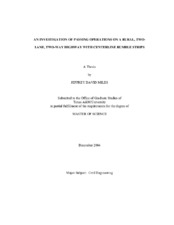| dc.description.abstract | The research in this thesis was conducted to investigate the initial stage of passing maneuvers on a rural, two-lane, two-way (RTLTW) highway with centerline rumble strips (CRSs). Four measures of effectiveness were used: (1) number and type of erratic movements by a passing vehicle, (2) number of and time between centerline encroachments of a passing vehicle, (3) gap distance of a passing vehicle, and (4) centerline crossing time. Data were collected for a before-and-after analysis at one site, in Comanche County, Texas. The test section was on US 67 from Comanche, Texas to the county line south of Dublin, Texas. The posted speed limit for this RTLTW highway was 70 mph during the day.
CRSs were installed along approximately 15 miles of US 67. Only one test design for CRSs was installed. The design specification was for a CRS to be milled to a 0.5-inch depth, 7-inch length, and 16-inch width. This specification was developed from current state practices throughout the United States. CRSs were installed continuously through passing and no-passing zones, and they were spaced at 24 inches on-centers. Pavement markings were striped over the CRSs.
Data were collected using an innovative data collection system developed by the author through the Texas Transportation Institute (TTI). This system was mounted to a four-door sedan, and it consisted of four concealed cameras that recorded the entire passing maneuver around the data collection vehicle.
Data were collected at three different speeds during the daytime. The speeds were 55, 60, and 65 mph (15, 10, and 5 mph, respectively, under the posted speed limit).
Based on the assessment of the four MOEs, the overall finding of this thesis was that driver performance during the initial phase of passing maneuvers was not negatively impacted after the installation of CRSs on US 67.
The caveat is that differences in the weather conditions may have influenced the results. The weather was dry with clear skies at the study site during data collection prior to the installation of CRSs; however, the weather consisted of intermittent rain during the data collection after the installation of CRSs. | en |


